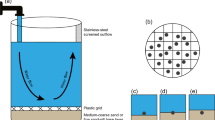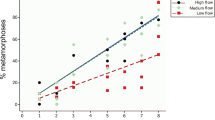Abstract
Robust redhorse (Moxostoma robustum) is a rare riverine sucker for which life history information is scarce. Spawning occurs over loose gravel substrate and eggs and larvae may be adversely affected by fine sediments among the gravel. A 2-year study was conducted to determine the threshold at which fine sediments are detrimental to successful egg incubation and larval emergence. Year 1 gravel treatments contained 0, 25, 50, and 75% fine sediments. Mean survival during Year 1 ranged from 63.5% in the 0% fine sediment treatment to 0% in the 75% fine sediment treatment. The results also indicated an adverse affect threshold between 0 and 25% fine sediment. Year 2 gravel treatments contained 0, 5, 10, 15, 20, and 25% fine sediments. Mean survival during Year 2 ranged from 69.8% in the 0% treatment to 9.1% in the 25% treatment. Year 2 results also identified the 15% fine sediment treatment as the threshold at which survival began to decline. Substrates at one known spawning area used by robust redhorse typically contain 25 to 50% fine sediment, but the spawning act cleans some fines from the egg pocket. Whether the “cleaning” that results from the spawning act reduces the fines sufficiently to avoid adverse effects is unknown. According to our results, survival rates of robust redhorse eggs and larvae are predicted to be about 8.0% or less when fine sediment is >25%.




Similar content being viewed by others
References
Berkman HE, Rabeni CF (1987) Effect of siltation on stream fish communities. Environ Biol Fishes 18:285–294
Bjornn TC (1969) Embryo survival and emergence studies. Job No. 5, Federal Aid in Fish and Wildlife Restoration. Job Completion Report Project F-49-R-7. Idaho Fish and Game Department
Burr BM, Morris MA (1977) Spawning behavior of the shorthead redhorse, Moxostoma macrolepidotum, in Big Rock Creek, Illinois. Trans Am Fish Soc 99:546–559
Chapman DW (1988) Critical review of variables used to define effects of fines in redds of large salmonids. Trans Am Fish Soc 117:1–21
Coble DW (1961) Influence of water exchange and dissolved oxygen in redds on survival of steelhead trout embryos. Trans Am Fish Soc 90:469–474
Cope ED (1870) Partial synopsis of the fishes of the fresh waters of North Carolina. Proc Amer Phil Soc 11:448–495
Dilts EW (1999) Effects of fine sediment and gravel quality on survival to emergence of larval robust redhorse Moxostoma robustum. Master’s thesis, University of Georgia, Athens, GA
EA Engineering Science and Technology Inc (1994) Sinclair hydroelectric project relicensing technical studies: Oconee River fluvial geomorphology report (FERC Project No. 1951). Report submitted to Georgia Power Company, Atlanta, GA
Evans JW (1994) A fishery survey of Oconee River between Sinclair Dam and Dublin, Georgia. Georgia Department of Natural Resources, Wildlife Resources Division. Final report, Federal Aid Project F-33. Social Circle, Georgia
Fajen OF, Layzer JB (1993) Agricultural practices. In: Bryan CF, Rutherford DA (eds) Impacts on warmwater streams: guidelines for evaluation. American Fisheries Society, Southern Division, Bethesda, pp 257–270
Freeman BJ (1998) Ecological Studies on the robust redhorse (Moxostoma robustum) in the Oconee River and Broad River systems, Georgia. Final Report. US Geological Survey, Biological Resources Division research work order number 37. University of Georgia, Athens, Georgia
Greig SM, Sear DA, Carling PA (2005) The impact of fine sediment accumulation on the survival of incubating salmon progeny: implications for sediment management. Sci Total Environ 344:241–258
Hall JD, Lantz RL (1969) Effects of logging on the habitat of coho salmon and cutthroat trout in coastal streams. In: Northcote TG (ed) Symposium on salmon and trout in streams. University of British Columbia, Vancouver, pp 355–375
Harvey BC (1987) Susceptibility of young-of-the-year fishes to downstream displacement by flooding. Trans Am Fish Soc 116:851–855
Harvey BC (1991) Interactions of abiotic and biotic factors influencing larval fish survival in an Oklahoma stream. Can J Fish Aquat Sci 48:1476–1480
Hausle DA, Coble DW (1976) Influence of sand in redds on survival and emergence of brook trout (Salvelinus fontinalis). Trans Am Fish Soc 105:57–63
Jenkins RE, Jenkins DJ (1980) Reproductive behavior of the greater redhorse, Moxostoma valenciennesi, in the Thousand Islands region. Can Field Nat 94:426–430
Jennings CA, Shelton JL Jr, Freeman BJ, Looney GL (1996) Culture techniques and ecological studies of the robust redhorse Moxostoma robustum. Annual Report (1995) prepared for Georgia Power Company, Environmental Affairs Division, Atlanta, Georgia Project Number 25-21-RC295-387 University of Georgia, Athens
Kondolf GM, Sale MJ, Wolman MG (1993) Modification of fluvial gravel size by salmonids. Water Resour Res 29:2265–2274
Koski KV (1966) The survival of coho salmon (Onchorynchus kisutch) from egg deposition to emergence in three Oregon coastal streams. Master’s thesis, Oregon State University, Corvallis, OR
Kwak TJ, Skelly TM (1992) Spawning habitat, behavior, and morphology as isolating mechanisms of the golden redhorse, Moxostoma erythrurum, and the black redhorse, M. duquesnei, two synoptic fishes. Environ Biol Fishes 34:127–137
Luft ER (1986) Channel changes along the lower Oconee River, Georgia: 1805–1949. Master’s thesis, University of Georgia, Athens, GA
McCullagh P, Nelder JA (1983) Generalized linear models. Chapman and Hall, New York
McNeil WJ (1966) Effects of the spawning bed environment on reproduction of pink and chum salmon. U. S. Fish Wildl Serv Fish Bull 65:495–523
Merz JE, Setka JD (2004) Evaluation of a spawning habitat enhancement site for Chinook salmon in a regulated California river. N Am J Fish Manage 24:397–407
Meyer CB, Sparkman MD, Klatte BA (2005) Sand seals in coho salmon redds: do they improve egg survival? N Am J Fish Manage 25:105–121
Mih WC, Bailey GC (1981) The development of a machine for the restoration of stream gravel for spawning and rearing of salmon. Fisheries 6(6):16–20
Montgomery DR, Buffington JM, Peterson NP, Schuett-Hames D, Quinn TP (1996) Stream-bed scour, egg burial depths, and the influence of salmonid spawning on bed surface mobility and embryo survival. Can J Fish Aquat Sci 53:1061–1070
Muncy RJ, Atchison GJ, Bulkley RV, Menzel RW, Perry LG, Summerfelt RC (1979) Effects of suspended solids and sediment on reproduction and early life history of warmwater fishes: a review. US Environmental Protection Agency EPA600/3-79-042 Washington, DC
Phillips RW, Lantz RL, Claire EW, Moring JR (1975) Some effects of gravel mixtures on emergence of coho salmon and steelhead trout fry. Trans Am Fish Soc 104:461–466
Piper RG, McElwain IB, Orme LE, McCraren JP, Fowler LG, Leonard JR (1982) Fish hatchery management. U.S. Department of the Interior, Fish and Wildlife Service, Washington, DC
Reiser DW, White RG (1988) Effects of two sediment size-classes on survival of steelhead and chinook salmon eggs. N Am J Fish Manage 8:432–437
Ruetz CR III, Jennings CA (2000) Swimming performance of larval robust redhorse Moxostoma robustum and low-velocity habitat modeling in the Oconee River, Georgia. Trans Am Fish Soc 129:398–407
Ruhlman MB, Nutter WL (1999) Channel Morphology evolution and overbank flow in the Georgia piedmont. J Am Water Res Assoc 35:277–290
SAS Institute Inc (1990) SAS Procedures Guide, Version 6, 3rd edn. Cary, NC
Sear DA (1993) Fine sediment infiltration into gravel spawning beds within a regulated river experiencing floods: ecological implications for salmonids. Regul Rivers Res Manage 8:373–390
Shields FD Jr, Milhous R, Adams JR, MacAuthor RC (1992) Sediment and aquatic habitat in river systems. J Hydrau Eng 118:669–687
Smith HG, Burnard RK, Good EE, Keener JM (1973) Rare and endangered vertebrates of Ohio. Ohio J Sci 73:257–271
Sokal RR, Rohlf FJ (1981) Biometry: the principles and practice of statistics in biological research, 2nd edn. WH Freeman and Company, New York
Tappel PD, Bjornn TC (1983) A new method of relating size of spawning gravel to salmonid embryo survival. N Am J Fish Manage 3:123–135
Trimble SW (1977) The fallacy of stream equilibrium in contemporary denudation studies. Am J Sci 277:876–887
Waters TF (1995) Sediment in streams: sources, biological effects, and control. American Fisheries Society Monograph 7, Bethesda, Maryland
Wesche TA (1993) Watershed management and land-use practices. In: Kohler CC, Hubert WA (eds) Inland fisheries management in North America. American Fisheries Society, Bethesda, pp 181–203
Weyers RS, Jennings CA, Freeman MC (2003) Effects of pulsed, high-velocity water flow on larval robust redhorse and V-Lip redhorse. Trans Am Fish Soc 132:84–91
Acknowledgements
This research was funded by Georgia Power Company. The Georgia Cooperative Fish and Wildlife Research Unit is sponsored by the Georgia Department of Natural Resources, the Wildlife Management Institute, the U.S. Fish and Wildlife Service, the U.S. Geological Survey, and the University of Georgia. We thank Don Dennerline, Brent Hess and Matt Lichtenwalner for technical assistance.
Author information
Authors and Affiliations
Corresponding author
Electronic supplementary material
Below is the link to the electronic supplementary material.
ESM 1
(DOC 25 kb)
Rights and permissions
About this article
Cite this article
Jennings, C.A., Dilts, E.W., Shelton, J.L. et al. Fine sediment affects on survival to emergence of robust redhorse. Environ Biol Fish 87, 43–53 (2010). https://doi.org/10.1007/s10641-009-9561-9
Received:
Accepted:
Published:
Issue Date:
DOI: https://doi.org/10.1007/s10641-009-9561-9




